- If the nodemanager.properties file is not present, continue installing Oracle Forms.
- If the nodemanager.properties file does exist, open it and verify that the ListenPort parameter is included and that it is set. If the ListenPort parameter is not included or set, edit the nodemanager.properties file so that it is similar to the following, where NODE_MANAGER_LISTEN_PORT represents the port the Node Manager listens on, such as 5556:
ListenPort=NODE_MANAGER_LISTEN_PORT
Installing Oracle Identity and Access Management
Protect your Oracle Forms installation with Identity Management using Oracle Identity and Access Management.
If you choose to use Oracle Internet Directory and Oracle Access Manager, download and install these products if you do not already have them. Refer to Reviewing Certification, System, and Interoperability Requirements to determine which versions of these products have been certified for use with your Oracle Forms release.
To install and configure Oracle Internet Directory with Oracle Access Manager:
- Install Oracle Identity and Access Management in a separate Oracle home directory from your Oracle Forms installation. See Installing and Configuring the Oracle Access Management Software in Installing and Configuring Oracle Identity and Access Management . Do not attempt to install Oracle Access Manager or Oracle Internet Directory in the same Oracle home directory with Fusion Middleware Infrastructure and Forms. For performance reasons, Oracle recommends that Oracle Forms is installed on a separate machine from your Oracle Identity Management product.
- Configure a WebLogic Server domain for Oracle Access Manager, as described in Configuring the Oracle Access Management Domain in Installing and Configuring Oracle Identity and Access Management .
- Integrate Oracle Access Manager with Oracle Internet Directory, as described in Configuring Oracle SOA Suite Domain in Installing and Configuring Oracle SOA Suite and Business Process Management .
If you have an existing Oracle Internet Directory with Oracle Single Sign-On, you can upgrade to Oracle Internet Directory with Oracle Access Manager, as described in Upgrading Oracle Forms.
Installing and Configuring Oracle Forms
You have to perform a series of steps to install and then configure Oracle Forms using the configuration wizard.
The following sections are included:
- Starting the Oracle Forms Installer
- View the Installation Log Files
- Configuring Your Oracle Inventory (UNIX)
- Installing Using Oracle Universal Installer
- Using the Repository Creation Utility
- Configuring Forms Using the Configuration Wizard
- Configuring Form Builder Standalone Using the Configuration Wizard
Starting the Oracle Forms Installer
To start the installer, navigate to the directory where you have downloaded the Forms compressed folder containing the installer files.
- Extract the compressed folder: fmw_12.2.1.4.0_fr_win64_Disk1_1of2.zip The following executable .exe file is extracted from the zip file: setup_fmw_12.2.1.4.0_fr_win64.exe
- To start the installer, either run it in an elevated DOS shell or right-click and select "Run as administrator".
On UNIX/Linux operating systems, an executable .bin file is extracted from the compressed folder, which is used to start the installer.
unzip fmw_12.2.1.4.0_fr_linux64_Disk1_1of2.zip ./fmw_12.2.1.4.0_fr_linux64.bin- The Forms 12 c Disk-1 compressed installer files folder for IBM AIX operating system does not include the rootpre.sh script files. So, you do not need to run the rootpre.sh script as the root user before starting the installer. The rootpre.sh script was used in previous version of FMW installer to load postwait driver pw-syscall .
- When running the Forms and Reports bin installer on the IBM AIX platform, the installer may core dump when the progress reaches 98%. To work around this issue and successfully complete installation, launch the installer with the following JVM parameters. -J-Xmx2048m -J-XX:MaxPermSize=2048m Here is an example. ./fmw_12.2.1.4.0_fr_aix_ppc64.bin -J-Xmx2048m -J-XX:MaxPermSize=2048m
- Some platforms may have multiple download files or disks, such as Disk-1 and Disk-2 . You should extract all the files, for example executable .exe file, from the downloaded compressed (zipped) folder. If the downloaded compressed (zipped) folder contains another compressed (zipped) file, you should not extract that compressed file contained within the original compressed (zipped) folder. You should store all the extracted files from the compressed folder in the same directory before starting the installer.
View the Installation Log Files
The installer writes logs files to the Oracle_Inventory_Location /log (on UNIX operating systems) or Oracle_Inventory_Location \logs (on Windows operating systems) directory. See Installation Log Files for information about log files and their contents.
Configuring Your Oracle Inventory (UNIX)
If you are installing on a UNIX operating system, and if this is the first time any Oracle product is being installed on your system with the Oracle Universal Installer, you will be asked to provide the location of an inventory directory. This is where the installer will set up subdirectories and maintain inventory data for each Oracle product that is installed on this system.
Use the inventory screens in Table 2-1 to configure the inventory directory and group information. For more help, select the screen name in the table, or click the Help button in the GUI.
Table 2-1 Inventory Directory and Group Screens
Specify Inventory Directory
Specify the Oracle inventory directory and group permissions for that directory. The group must have write permissions to the Oracle inventory directory.
Inventory Location Confirmation
Run the createCentralInventory.sh script as root .
If you do not want to use the Oracle central inventory, you can create a file called oraInst.loc and in this file, include the full path of the inventory directory of your choice. For example, a typical oraInst.loc file would contain the following:
inventory_loc=/home/username/oraInventory inst_group=group
Then, you can start the installer and point to the oraInst.loc file. For example:
./fmw_12.2.1.4.0_fr_linux64.bin -invPtrLoc /location_of_oraInst.loc_file
Installing Using Oracle Universal Installer
Follow these instructions to install Oracle Forms using Oracle Universal Installer. After invoking Oracle Universal Installer as described in Starting the Oracle Forms Installer:
- Welcome page. This page welcomes you to the installation. Click Next .
- The Auto Updates page appears. This page enables you to choose to automatically receive software updates for your components from Oracle Corporation. Make your choices, then click Next .
- The Installation Location page appears. Specify the Oracle home location into which you want to install the product(s). Click Next .
- The Installation Type page appears. You can select Standalone Forms Builder if you want only that functionality, or choose Forms Deployment to install all of the products. Click Next .
- The Prerequisites Checks page appears. This page shows you the progress of the system checking the prerequisites on your system before installation. If you are lacking any prerequisites, a message will appear telling you so. You do not need to take any actions on this page, though you can view the log from here. Click Next .
- The Installation Summary page appears, showing you what components and features are about to be installed. If you need to make changes, click Back , otherwise, click Install to start the installation.
- The Installation Progress page appears. This page shows you the progress of the installation, and will warn you if there are any problems.You can view messages and logs from this page, but typically no action is required here. When progress is complete, click Next (go to a Summary page). Alternatively, you can click Finish .
- If you clicked Next , the Installation Complete page appears, showing you the components that have been installed. Click Finish .
Using the Repository Creation Utility
Before proceeding to the next tasks, follow the instructions in this topic to set up Repository Creation Utility (RCU) schemas for configuring Oracle Forms.
If you are planning to create the WebLogic Infrastructure Repository in Oracle Autonomous Database, be sure to install the following patches before running the Repository Creation Utility (RCU):
RCU is available with the Oracle Fusion Middleware Infrastructure distribution. After you install Oracle Fusion Middleware Infrastructure and create your Oracle home, you can start RCU from the ORACLE_HOME/oracle_common/bin directory. Follow these instructions to set up schemas.
Run $FMW_HOME/oracle_common/bin/rcu.sh . Unless otherwise noted, click Next to continue to the next screen.
Table 2-2 Schema Setup Steps
This screen introduces you to RCU.
Select Create Repository , then select System Load and Product Load (default).
Database Connection Details
Specify RCU database connection credentials.
Click Next when you have specified your credentials. The Checking Prerequisites dialog window appears. It shows the progress of prerequisites checking. Click OK , when the database checking has passed without errors, to dismiss the dialog window, and go to the next screen.
Select the Create new prefix radio button and provide a schema prefix (such as DEMO ).
You must remember the prefix and schema names for the components you are installing. It is recommended that you write down these values.
- Oracle Platform Security Services
- User Messaging Service (UMS)
Tip: If Forms Application Deployment Services (FADS) is also planned to be configured, include User Messaging Services (UMS).
Additional dependent components will automatically be selected.
The Checking Prerequisites pops up box appears. It shows the progress of prerequisites checking. Click OK , when it is complete, to dismiss the dialog window and go to the next screen.
Leave the default Use same passwords for all schemas radio button selected, and enter the password in the Password field.
You must remember the passwords you enter on this screen; you need this information during the configuration phase of product installation. It is recommended that you write down these values.
Use this screen to configure the desired tablespace mapping for the schemas that you want to setup.
When you click Next , Repository Creation Utility dialog window appears, asking you to confirm that you want to create these tablespaces. Click OK to proceed and dismiss the dialog window.
A second dialog window, Creating Tablespaces appears showing the progress of tablespace creation. Click OK , after the tablespaces are created, to dismiss this window and go to the next screen.
Verify the information on this screen, then click Create to begin schema setup.
A System Load progress dialog window appears, showing progress. The dialog window will disappear when complete.
Review the information on this screen to verify that the operation was completed successfully. Click Close to complete the schema setup and close RCU.
Configuring Forms Using the Configuration Wizard
The Configuration Wizard helps and simplifies the task of configuring Oracle Forms.
The Configuration Wizard shows a series of screens where you verify or enter information.
To complete the configuration, Windows DOS shells must be run with Administrator permissions and Unix shells must be owned by the same user who performed the installation (for example, oracle ). Failure to follow this instruction may result in the configuration failing silently.
Perform the following steps in the Configuration Wizard:
- Run the Configuration Wizard using config.sh (config.cmd on Windows) located in the ORACLE_HOME/oracle_common/common/bin directory.
- Choose Create a new domain , and enter the desired domain home path.
- Click Next . The Templates screen appears. Keep the default selection ( Create Domain using Product Templates ), and select Oracle Forms [forms]. Any dependent templates will be automatically selected. Additional templates, like Oracle HTTP Server and others, can be selected based on the components desired. Refer to those individual component documents for more details.
- Click Next . The Application Location screen appears. Keep the default value for Application location.
- Click Next . The Administrator Account screen appears. Enter the desired WebLogic Domain administration username and password. This information will be needed to access WebLogic Server Control and Fusion Middleware Control.
- Click Next . The Domain Mode and JDK screen appears. Select the Domain Mode (either Development or Production ). To ensure the highest degree of security, selecting Production is recommended. Retain the default JDK selection unless you need to use a different version the JDK.
- Click Next . The Database Configuration Type screen appears. Enter the RCU DB connection information. This information was created when running the Repository Creation Utility (RCU) in an earlier step. After entering the requested information, click Get RCU Configuration . Verify that a successful message is presented in the Results Log panel. If an indication of success is not indicated, check the databases entries made in this step. Mostly it will only be necessary to enter data for DBMS/Service , Host Name , Port , Schema Owner , and Schema Password . Other entries can remain as the default value.
- Click Next . The JDBC Component Schema screen appears. These instructions assume each Repository schema uses the same password. If not, enter the correct schema passwords.
- Click Next . The JDBC Component Schema Test screen appears. If any tests fail, it may be necessary to go back and make corrections.
- Click Next . The Advanced Configuration screen appears. Select Topology and System Components . Depending on the level of customization desired, other selections may be used.
- Using Server Templates in Understanding Domain Configuration for Oracle WebLogic Server .
- Creating and Configuring Dynamic Clusters in Administering Clusters for Oracle WebLogic Server .
- If Oracle HTTP Server (OHS) was selected in the Templates screen, the OHS component would need to be added in this step.
- Click the Add button to add the OHS component and then click Next button.
- Accept the default settings for the OHS Server component and then click Next button.
-
On Unix/Linux platforms, the shell used to start these servers the first time, must be the installation owner's (for example, oracle ).
On Microsoft Windows, the DOS shell used to start these servers the first time must have Administrator permissions. To enable an Administrator shell session, right-click the Command Prompt shortcut and select Run as Administrator . The shell that opens will indicate that it has Administrator privileges in its title bar.
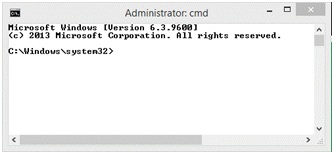
Figure 2-1 Command Prompt with Administrator Privileges
Description of "Figure 2-1 Command Prompt with Administrator Privileges"
For more information on how to start and stop servers, review Starting and Stopping Servers.
Configuring Form Builder Standalone Using the Configuration Wizard
Describes how to install and configure the Form Builder Standalone environment.
Perform the following steps to configure the Form Builder Standalone environment:
- Install the Form Builder Standalone 12 c software. Start the Installer as described in Starting the Oracle Forms Installer. Follow the prompts. You must install into a new and empty Oracle home.
- Launch the Form Builder Configuration Assistant using one of the following methods:
- Choose to run it after the Form Builder Standalone software installation. After the installation is complete, check the Automatically Launch Forms Builder Configuration Wizard option and click Finish .
- Launch the configuration tool later from the location. $FMW_HOME/forms/common/bin/config_builder.sh .

Figure 2-2 Launching the Configuration Tool in Windows
Description of "Figure 2-2 Launching the Configuration Tool in Windows"- autoconfig - Specify to automatically configure a new instance named formsN where N is a sequential number starting with 1. Each time the command is run against this Oracle home, N increments by 1. The new instance is automatically created in the Oracle home.
- formBuilderInstance - Use this argument in conjunction the autoconfig argument to specify the path of the instance location. Specifying this parameter overrides the auto-naming behavior of the autoconfig argument. The path should be a value that does not include directories with spaces.
Here is an example of the command usage.
config_builder.cmd autoconfig formBuilderInstance=C:\myFormBuilder\inst1
To complete the configuration, Windows DOS shells must be run with Administrator permissions and UNIX shells must be owned by the same user who performed the installation (for example, oracle ). Failure to follow this instruction may result in the configuration failing silently.
Verifying the Installation and Configuration
After you complete the installation and configuration of Oracle Forms, verify it was successful by performing a series of tasks.
You can verify the status of your installation by performing the tasks in any combination.
- Reviewing the Installation Logs
- Reviewing the Domain Server Logs
- Checking the Installed Products and Product Versions
- Checking Browser URLs
- Performing Basic Administration Tasks
Reviewing the Installation Logs
Check for the presence of installation log files in logs directory inside your Oracle Inventory directory.
On UNIX operating systems, if you do not know the location of your Oracle Inventory directory, you can find it in the ORACLE_HOME /oraInst.loc file.
On Windows operating systems, the location for the inventory directory is C:\Program Files\Oracle\Inventory\logs .
For information about installation log files, see Installation Log Files.
Reviewing the Domain Server Logs
You can check the domain server logs, which are located in the servers directory inside the domain home directory.
On UNIX operating systems:
DOMAIN_HOME/servers/server_name
On Windows operating systems:
DOMAIN_HOME\servers\server_name
Checking the Installed Products and Product Versions
The contents of your installation vary based on the options that you selected during the installation.
Check the products and product version numbers by running the opatch lsinventory -detail command from the ORACLE_HOME /OPatch directory.
Checking Browser URLs
To verify the installed products URLs are provided.
The Installation Complete screen contains URLs that can be used to access your installed and configured products, as described in the following table.
Table 2-3 Oracle Forms Product URLs
Administration Server Console
http:// host : port /console
Enterprise Manager Console
http:// host : port /em
http:// host : port /forms/frmservlet
Performing Basic Administration Tasks
After running the installer and configuration tool, all of your system components, the Administration Server, and Managed Servers should be manually started in order to complete the configuration process.
In the event that some of your servers or components are stopped unexpectedly, you can restart your Oracle Fusion Middleware environment by following the instructions, as described in Starting an Oracle Fusion Middleware Environment.
Your Oracle Fusion Middleware environment can also be stopped, as described in Stopping an Oracle Fusion Middleware Environment.
Installing Oracle Forms in Silent Mode
This section describes how to install Oracle Forms from the command line in silent mode.
You can use the silent installation mode to bypass the need to monitor your product installation because no graphical output is displayed and no input by the user is required. To install Oracle Forms in silent mode, use the -silent flag on the command line when you start the installer.
Silent installation does not include configuration. That is, you cannot configure Oracle Forms silently using the same silent installation commands and response file. In this release, product installation and configuration are separate processes. The Configuration Wizard cannot be run in silent mode (or used with response files) in this release.
See the following sections in Installing Software with the Oracle Universal Installer , for details on silent mode:
- About Silent Installation
- About Response Files
- Running the Oracle Universal Installer in Silent Mode
After you have completed the installation in silent mode, perform the separate step-by-step process in the following sections to configure Oracle Forms using the Configuration Wizard:
- Configuring Forms Using the Configuration Wizard
- Configuring Form Builder Standalone Using the Configuration Wizard
Deinstalling in Silent Mode
Follow the instructions in Running the Oracle Universal Installer for Silent Deinstallation, to deinstall Oracle Forms in silent mode.
Installing the Forms Application Deployment Services
The Forms Application Deployment Services (FADS) simplifies the process of packaging applications, deploying, configuring, and storing archived copies of the applications. Follow the instructions in this section to install and configure Forms Application Deployment Services (FADS) .
The followings sections are included:
- Prerequisites for Installation
- Configuring Forms Application Deployment Services
- Run FADS Post Configuration Steps
Prerequisites for Installation
Forms Application Deployment Services is available in the latest Oracle Forms and Reports 12 c shiphome.
To complete the installation and begin configuring FADS, you should install the following products in the given order:
- Oracle WebLogic Server Infrastructure 12 c (12.2.1.4.0)
- Oracle Forms 12 c (12.2.1.4.0)
- Oracle SQL Developer 18.2 (or higher)
An existing older version of SQL Developer is installed with the latest Forms release. You need to rename the sqldeveloper directory located in the $ORACLE_HOME directory before installing Oracle SQL Developer 18.2 (or higher) in the same $ORACLE_HOME directory.
Configuring Forms Application Deployment Services
After you have completed the installation steps, you can start configuring Forms Application Deployment Services applications.
You have to perform the following FADS application configuration steps in a Fusion Middleware domain:
- Setting up RCU Schema
- Apply the FADS Template
As a prerequisite, Repository Creation Utility Schemas must be set up for configuring Oracle Forms or FADS domain. Configuring FADS will require the Repository's User Messaging Service (UMS) and its dependencies. See Setting up RCU Schema.
Setting up RCU Schema
Follow the instructions in this section to set up Repository Creation Utility (RCU) schemas for configuring Oracle Forms or FADS domain.
RCU is available with the Oracle Fusion Middleware Infrastructure distribution. After you install Oracle Fusion Middleware Infrastructure and create your Oracle home, you can start RCU from the ORACLE_HOME/oracle_common/bin directory. Follow these instructions to set up schemas.
Run $ORACLE_HOME/oracle_common/bin/rcu.sh . Unless otherwise noted, click Next to continue to the next screen.
Table 2-4 Schema Setup Steps
This screen introduces you to RCU.
Select Create Repository , then select System Load and Product Load (default).
Database Connection Details
Specify RCU database connection credentials.
Click Next when you have specified your credentials. The Checking Prerequisites dialog window appears. It shows the progress of prerequisites checking. Click OK , when the database checking has passed without errors, to dismiss the dialog window, and go to the next screen.
Select the Create new prefix radio button and provide a schema prefix (for example, FADS).
You must remember the prefix and schema names for the components you are installing. It is recommended that you write down these values.
- Oracle Platform Security Services
- User Messaging Service (UMS)
- Audit Services
- Audit Services Append
- Audit Services Viewer
Additional dependent components will automatically be selected.
The Checking Prerequisites pops up box appears. It shows the progress of prerequisites checking. Click OK , when it is complete, to dismiss the dialog window and go to the next screen.
Leave the default Use same passwords for all schemas radio button selected, and enter the password in the Password field.
You must remember the passwords you enter on this screen; you need this information during the configuration phase of product installation. It is recommended that you write down these values.
Use this screen to configure the desired tablespace mapping for the schemas that you want to setup.
When you click Next , Repository Creation Utility dialog window appears, asking you to confirm that you want to create these tablespaces. Click OK to proceed and dismiss the dialog window.
A second dialog window, Creating Tablespaces appears showing the progress of tablespace creation. Click OK , after the tablespaces are created, to dismiss this window and go to the next screen.
Verify the information on this screen, then click Create to begin schema setup.
A System Load progress dialog window appears, showing progress. The dialog window will disappear when complete.
Review the information on this screen to verify that the operation was completed successfully. Click Close to complete the schema setup and close RCU.
Apply the FADS Template
Apply the FADS template using the Configuration Wizard.
You can create a new domain by selecting the FADS template in the Configuration Wizard. When you select the FADS template, it automatically selects the Forms template as a dependency. This configures Forms in the Domain along with the FADS Applications. Alternatively, you can also configure FADS in a Forms domain by applying the FADS template later.
The following topics are included:
- Creating a New Domain that Includes Both Forms and FADS
- Applying FADS Template to an Existing Forms Domain
Creating a New Domain that Includes Both Forms and FADS
Follow the steps in this topic to create a new domain by using the FADS template.
Use the Configuration Wizard to create the new domain.Starting the Configuration Wizard
- Change to the following directory: (UNIX) ORACLE_HOME/oracle_common/common/bin (Windows) ORACLE_HOME\oracle_common\common\bin where ORACLE_HOME is your 12 c Oracle home.
- Enter the following command: (UNIX) ./config.sh (Windows) config.cmd
Creating the Domain
In the Configuration Wizard, you have to perform the steps similar to Forms configuration, as described in Configuring Forms Using the Configuration Wizard, but there are a few exceptions.
The following tasks performed in the Configuration Wizard screens, are not similar to the Forms configuration steps:
Templates screen: Select Forms Application Deployment Services (FADS) template check box, when selecting the domain template. The dependent templates, including Oracle Forms template, are automatically selected or included in the domain.
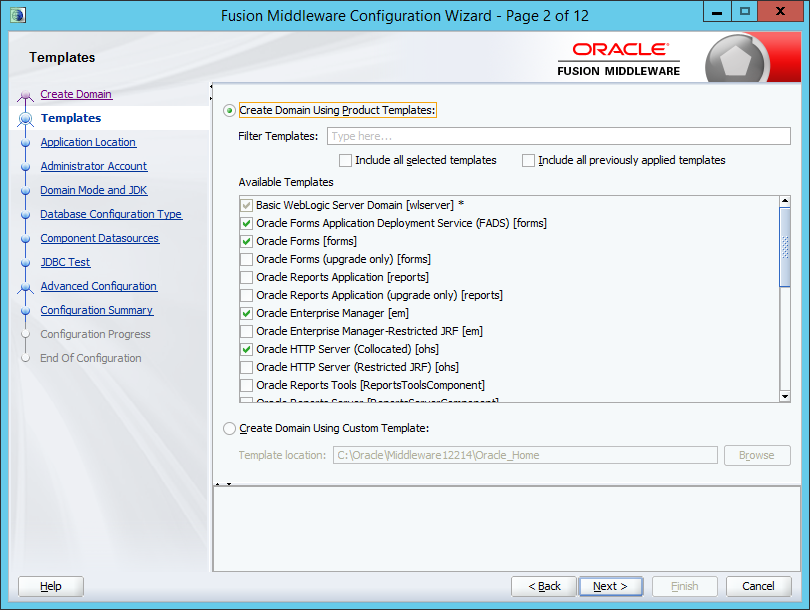
Figure 2-3 Templates Screen
Description of "Figure 2-3 Templates Screen"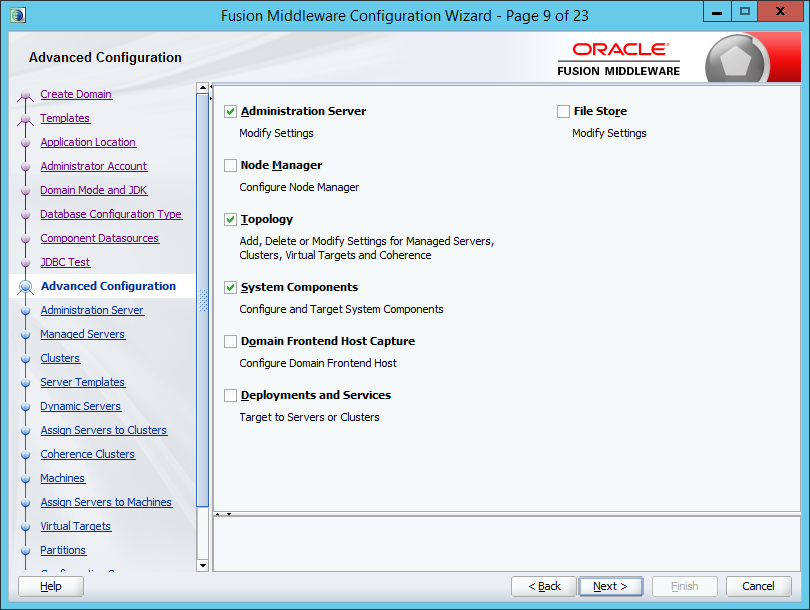
Figure 2-4 Advanced Configuration Screen
Description of "Figure 2-4 Advanced Configuration Screen"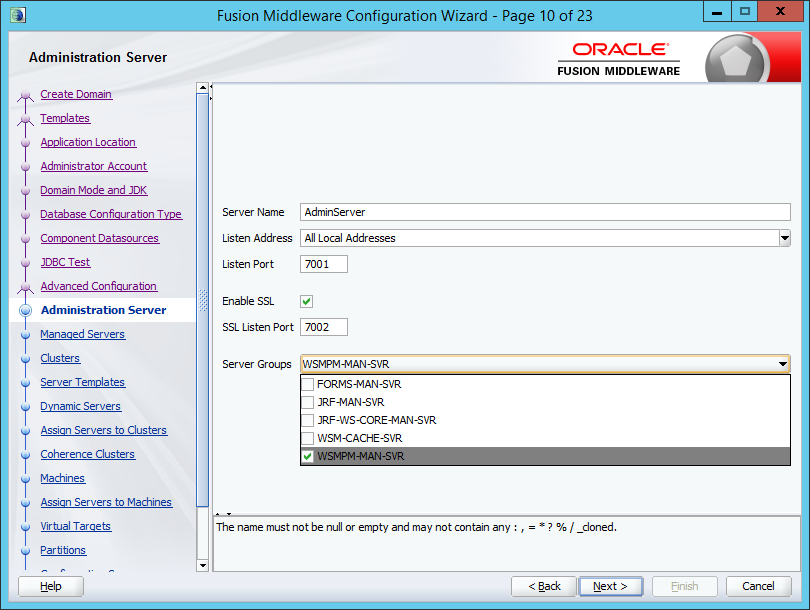
Figure 2-5 Administration Server Screen
Description of "Figure 2-5 Administration Server Screen"Writing Down Domain Home and Administration Server URL
The End of Configuration screen shows information about the domain just configured.
Make a note of the following items as they are required later:- Domain Location
- Administration Server URL
Domain location information is required for accessing scripts that start Administration Server, and URL for accessing the Administration Server.
Click Finish to exit the Configuration Wizard.
Starting the Administration Server
Start the Administration Server, after configuration is complete, and then perform the post configuration task described in Run FADS Post Configuration Steps.
Applying FADS Template to an Existing Forms Domain
This topic describes how to use the Configuration Wizard to apply FADS extension template to an existing Forms domain.
Start the Configuration Wizard, to begin the update process, as described in Creating a New Domain that Includes Both Forms and FADS.
Perform the following actions in the Configuration Wizard screens for extending an existing Forms Domain:
- Configuration Type screen: Select Update an Existing Domain . In the Domain Location field, Enter the full path for the Forms domain, or use the Browse button to navigate to the Forms domain. This field contains a drop-down list of the domains, if multiple domains exist in the Forms installation. Select the domain that you want to update from the drop-down list. Click Next to continue.
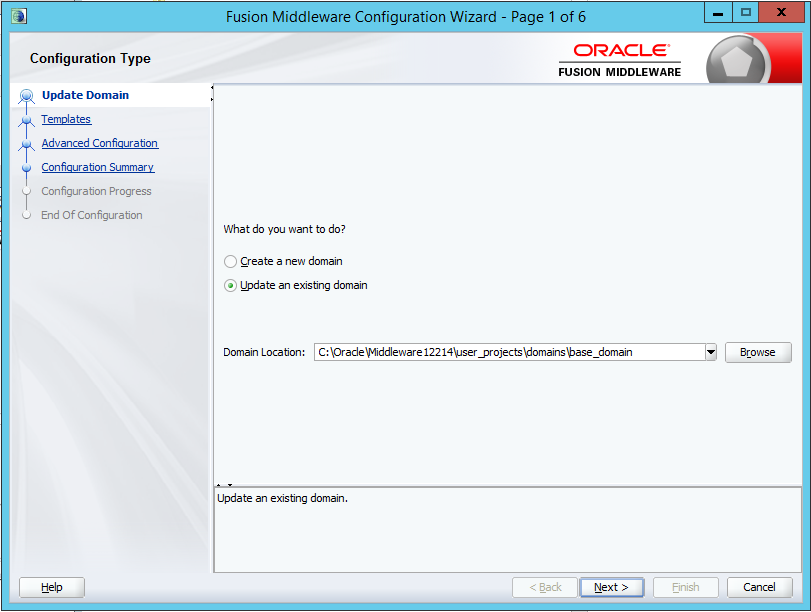
Description of the illustration fads_configuration-type.png - Templates screen: Select Update Domain Using Product Templates , and then select the Forms Application Deployment Services (FADS) check box to add to the domain. Click Next to continue.
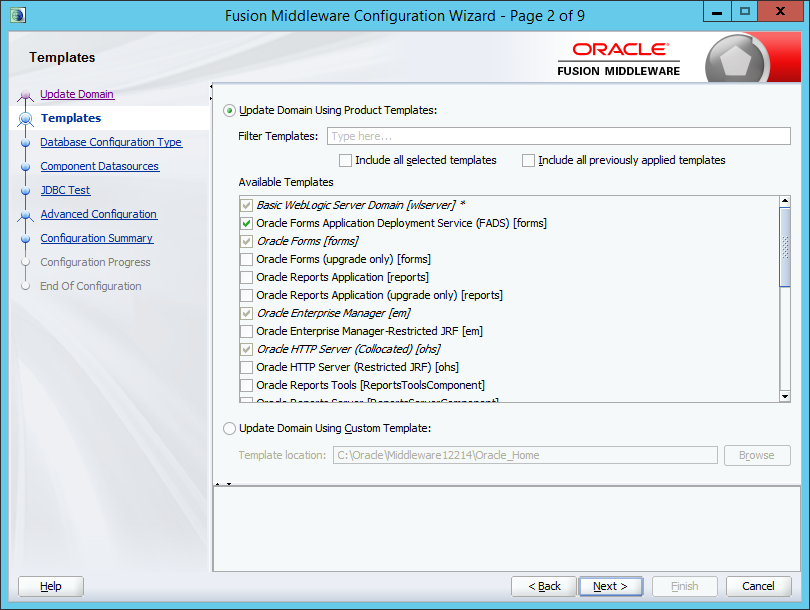
Description of the illustration fads_update-domain_templates.png - Advanced Configuration screen: Select the Deployments and Services checkbox. For this category you would be performing advanced configuration tasks. When extending a domain, you cannot change the Administration Server and Node Manager configurations. Therefore, these options are not available. Click Next to continue.
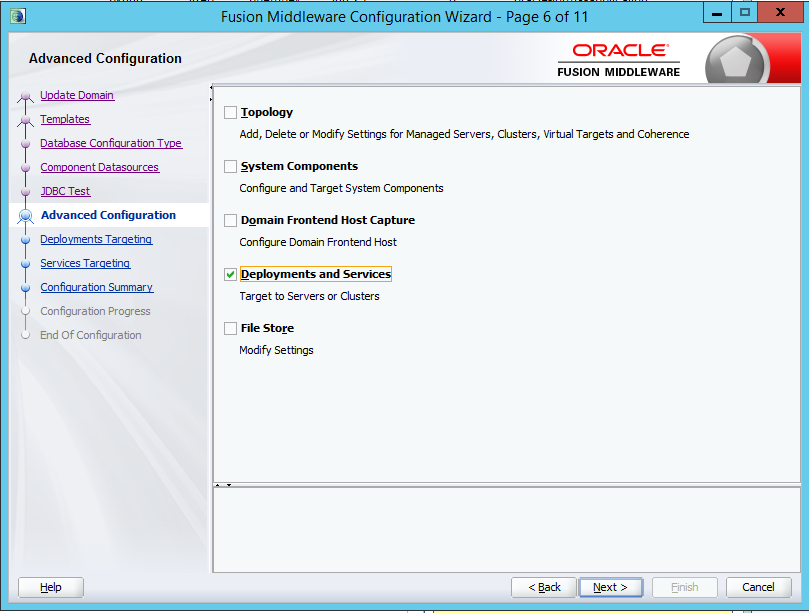
Description of the illustration fads_update-domain_adv-config.png - Deployments Targeting screen: Target applications for deployment on servers. This screen is displayed as you selected Deployments and Services on the Advanced Configuration screen.
- In the Deployment Targets list box, select WSM-PM application for the AppDeployment under the AdminServer .
- If WSM-PM application is not available in Deployment Targets list box, then select it under AppDeployment on the Deployments list box and then move it to AppDeployments under AdminServer in Deployment Targets list box, using the right arrow in the top-middle.

Description of the illustration fads_update-domain_deploy-targeting.png - Configuration Summary screen: Review the detailed configuration settings of your domain before continuing. In the Domain Summary pane, select an item to display details about that item in the Details pane on the right. You can limit the items that are displayed in the Domain Summary pane by selecting a filter option from the Summary View drop-down list. Click Back to return to the appropriate screen, if you need to change the configuration. Click Update to extend the domain, if the domain is configured as you want it.
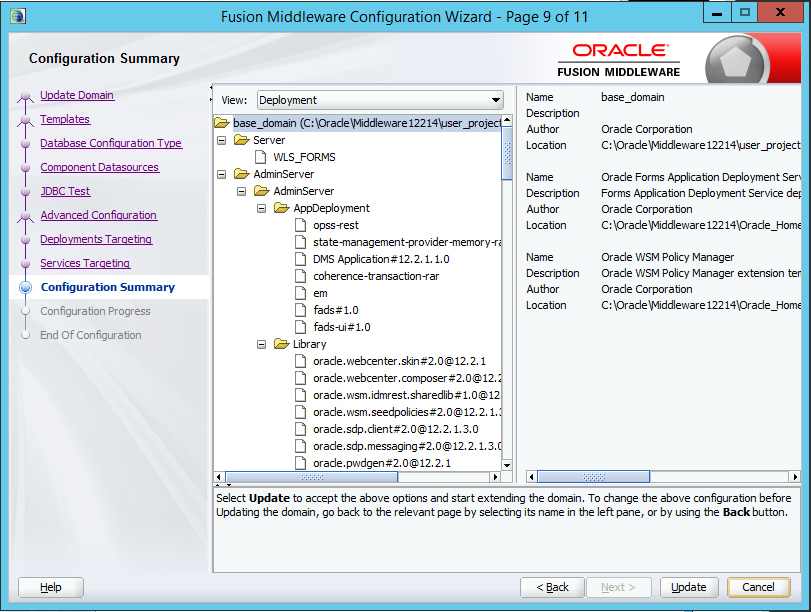
Description of the illustration fads_update-domain_config-summary.png - Configuration Progress screen: Shows the progress of the domain update. Click Next , when the process completes, .
- End of Configuration screen: Shows information about the Forms domain you just updated. Make a note of the following items because you need them later:
- Domain Location
- Administration Server URL
You need the domain location to access scripts that start Administration Server, and you need the URL to access the Administration Server. Click Finish to exit the Configuration Wizard.
Start the Administration Server, when you finish updating the Forms domain, and then perform the post configuration task described in Run FADS Post Configuration Steps.
Run FADS Post Configuration Steps
After creating or updating your Forms domain or after patching, you must perform few steps.
- If you created or updated your Forms domain, start the Node Manager, and then the Administration Server.
- Run one of the following sets of commands.
- If you created or updated your Forms domain, run the following set of commands. $ORACLE_HOME/oracle_common/common/bin/wlst.sh $ORACLE_HOME/forms/fads/fads_config.py config
- If you applied a new Forms patch set or one-off, execute the FADS post configuration script with the updateHostPort arguments. $ORACLE_HOME/oracle_common/common/bin/wlst.sh $ORACLE_HOME/forms/fads/fads_config.py updateHostPort www.example.com 7001 $ORACLE_HOME/user_projects/applications/base_domain
- Follow the prompts to complete the configuration.
- Perform one of the following steps:
- If you created or updated your Forms domain, restart the Node Manager, then the Administration Server, and Forms Managed Servers.
- If you applied a new Forms patch set or one-off, complete other patching steps and then start the Administration Server, Node Manager and Forms Managed Servers.
Oracle Forms Accessibility Information
This topic provides information about accessibility features and related information for Oracle Forms.
Oracle Forms Builder 12 c provides a range of features designed to support accessibility. While running Forms, you can configure your system and use features that support accessibility.
The Oracle Forms 12 c runtime is accessible if coded based on the instructions provided in Accessibility Features and Tips for Oracle Forms. This link also provides information about the minimum requirement that assistive technology must meet to run with Oracle Forms.